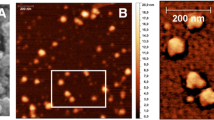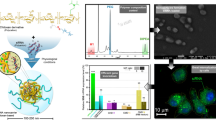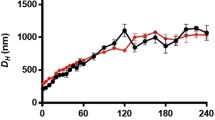Abstract
Chitosan-based polyplexes are known to traffic through lysosomes for a relatively long time, independent of the degree of deacetylation (DDA) and the number average molecular weight (Mn) of the polymer, even though both of these parameters have profound effects on polyplex stability and transfection efficiency. A better understanding of the lysosomal barrier is paramount to the rational design of vectors capable of overcoming obstacles to transgene expression. The aim of the present study was to investigate if lysosomal transit affects chitosan-based polyplex transfection efficiency in a structure-dependent (DDA, Mn) manner. Toward this end, we analyzed the effects of intracellular trafficking modifying agents on transfection efficiency and intracellular vesicular trafficking of polyplexes with different structural properties and stabilities or nucleic acid binding affinity. The use of agents that modify endosome/lysosome acidification and transit processes by distinct mechanisms and their effect on cell viability, polyplex uptake, vesicular trafficking, and transfection efficiency revealed novel and strong chitosan structure-dependent consequences of lysosomal transit. Inhibiting lysosomal transit using chloroquine significantly increased the efficiency of unstable polyplexes, while having minimal effects for polyplexes with intermediate or high stability. In parallel, specifically inhibiting the acidification of vesicles abrogated transfection for all formulations, suggesting that vesicular acidification is essential to promote transfection, most probably by facilitating lysosomal escape. These results provide novel insights into the structure–performance relationship of chitosan-based gene delivery systems.





Similar content being viewed by others
References
Lavertu, M., et al. (2006). High efficiency gene transfer using chitosan/DNA nanoparticles with specific combinations of molecular weight and degree of deacetylation. Biomaterials, 27(27), 4815–4824.
Strand, S. P., et al. (2009). Molecular design of chitosan gene delivery systems with an optimized balance between polyplex stability and polyplex unpacking. Biomaterials, 31(5), 975–987.
Thibault, M., et al. (2010). Intracellular trafficking and decondensation kinetics of chitosan-pDNA polyplexes. Molecular Therapy, 18(10), 1787–1795.
Thibault, M., et al. (2011). Excess polycation mediates efficient chitosan-based gene transfer by promoting lysosomal release of the polyplexes. Biomaterials, 32(20), 4639–4646.
Elouahabi, A., & Ruysschaert, J. M. (2005). Formation and intracellular trafficking of lipoplexes and polyplexes. Molecular Therapy, 11(3), 336–347.
Wattiaux, R., et al. (2000). Endosomes, lysosomes: their implication in gene transfer. Advanced Drug Delivery Reviews, 41(2), 201–208.
Ding, W., et al. (2005). Intracellular trafficking of adeno-associated viral vectors. Gene Therapy, 12(11), 873–880.
Chu, D. S., Johnson, R. N., & Pun, S. H. (2012). Cathepsin B-sensitive polymers for compartment-specific degradation and nucleic acid release. Journal of Control Release, 157(3), 445–454.
Shi, J., Schellinger, J. G., & Pun, S. H. (2013). Engineering biodegradable and multifunctional peptide-based polymers for gene delivery. Journal of Biological Engineering, 7(1), 25.
Koping-Hoggard, M., et al. (2004). Improved chitosan-mediated gene delivery based on easily dissociated chitosan polyplexes of highly defined chitosan oligomers. Gene Therapy, 11(19), 1441–1452.
Nordtveit, R. J., Varum, K. M., & Smidsrod, O. (1996). Degradation of partially N-acetylated chitosans with hen egg white and human lysozyme. Carbohydrate Polymers, 29(2), 163–167.
Jean, M., et al. (2009). Chitosan-plasmid nanoparticle formulations for IM and SC delivery of recombinant FGF-2 and PDGF-BB or generation of antibodies. Gene Therapy, 16(9), 1097–1110.
Ma, P. L., et al. (2009). New insights into chitosan-DNA interactions using isothermal titration microcalorimetry. Biomacromolecules, 10(6), 1490–1499.
Nimesh, S., et al. (2010). Enhanced gene delivery mediated by low molecular weight chitosan/DNA complexes: Effect of pH and serum. Molecular Biotechnology, 46(2), 182–196.
Sonawane, N. D., Szoka, F. C, Jr., & Verkman, A. S. (2003). Chloride accumulation and swelling in endosomes enhances DNA transfer by polyamine-DNA polyplexes. Journal of Biological Chemistry, 278(45), 44826–44831.
Khalil, I. A., et al. (2006). Uptake pathways and subsequent intracellular trafficking in nonviral gene delivery. Pharmacological Reviews, 58(1), 32–45.
Drose, S., & Altendorf, K. (1997). Bafilomycins and concanamycins as inhibitors of V-ATPases and P-ATPases. Journal of Experimental Biology, 200(1), 1–8.
Lavertu, M., et al. (2003). A validated H-1 NMR method for the determination of the degree of deacetylation of chitosan. Journal of Pharmaceutical and Biomedical Analysis, 32(6), 1149–1158.
Nguyen, S., Winnik, F. M., & Buschmann, M. D. (2009). Improved reproducibility in the determination of the molecular weight of chitosan by analytical size exclusion chromatography. Carbohydrate Polymers, 75(3), 528–533.
Bright, N. A., Gratian, M. J., & Luzio, J. P. (2005). Endocytic delivery to lysosomes mediated by concurrent fusion and kissing events in living cells. Current Biology, 15(4), 360–365.
Nazarian, R., Falcon-Perez, J. M., & Dell’Angelica, E. C. (2003). Biogenesis of lysosome-related organelles complex 3 (BLOC-3): A complex containing the Hermansky-Pudlak syndrome (HPS) proteins HPS1 and HPS4. Proceedings of the National Academy of Sciences of the United States of America, 100(15), 8770–8775.
Kaplan, I. M., Wadia, J. S., & Dowdy, S. F. (2005). Cationic TAT peptide transduction domain enters cells by macropinocytosis. Journal of Controlled Release, 102(1), 247–253.
Poon, G. M. K., & Gariepy, J. (2007). Cell-surface proteoglycans as molecular portals for cationic peptide and polymer entry into cells. Biochemical Society Transactions, 35, 788–793.
Lundberg, M., & Johansson, M. (2001). Is VP22 nuclear homing an artifact? Nature Biotechnology, 19(8), 713.
Weber, S. M., & Levitz, S. M. (2000). Chloroquine interferes with lipopolysaccharide-induced TNF-a gene expression by a nonlysosomotropic mechanism. Journal of Immunology, 165(3), 1534–1540.
Midoux, P., et al. (1993). Specific gene transfer mediated by lactosylated poly-l-lysine into hepatoma cells. Nucleic Acids Research, 21(4), 871–878.
Midoux, P., et al. (2009). Chemical vectors for gene delivery: a current review on polymers, peptides and lipids containing histidine or imidazole as nucleic acids carriers. British Journal of Pharmacology, 157(2), 166–178.
Richard, I., et al. (2013). Ionization behavior of chitosan and chitosan-DNA polyplexes indicate that chitosan has a similar capability to induce a proton-sponge effect as PEI. Biomacromolecules, 14(6), 1732–1740.
Koping-Hoggard, M., et al. (2003). Relationship between the physical shape and the efficiency of oligomeric chitosan as a gene delivery system in vitro and in vivo. The Journal of Gene Medicine, 5(2), 130–141.
Acknowledgments
This work was supported by the Canadian Institutes of Health Research (CIHR), the Natural Sciences and Engineering Research Council (NSERC), le Fond de la Recherche en Santé du Québec (FRSQ), and the Canada Foundation for Innovation (CFI). The authors thank Nicolas Tran-Khanh for comments that greatly improved the manuscript.
Author information
Authors and Affiliations
Corresponding author
Additional information
Marc Thibault and Marc Lavertu have contributed equally to this work.
Rights and permissions
About this article
Cite this article
Thibault, M., Lavertu, M., Astolfi, M. et al. Structure Dependence of Lysosomal Transit of Chitosan-Based Polyplexes for Gene Delivery. Mol Biotechnol 58, 648–656 (2016). https://doi.org/10.1007/s12033-016-9964-8
Published:
Issue Date:
DOI: https://doi.org/10.1007/s12033-016-9964-8




